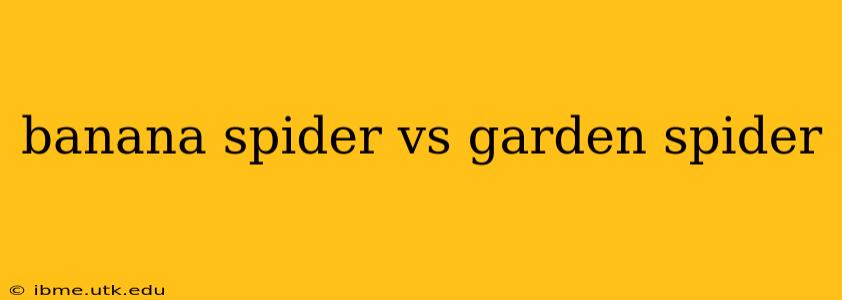Both banana spiders and garden spiders are fascinating arachnids, often encountered in gardens and other outdoor spaces. While they share some similarities as orb-weaving spiders, key differences exist in their appearance, size, web construction, and even temperament. This comprehensive guide will delve into the specifics of each, allowing you to confidently distinguish between these two common spider species.
What is a Banana Spider?
The term "banana spider" is a common name used for several large, brightly colored spiders, primarily from the Nephila genus. These spiders are known for their impressive size and their exceptionally strong, golden-colored webs. They are often found in tropical and subtropical regions. While many species fall under this common name, let's focus on some key characteristics:
-
Appearance: Banana spiders are typically large, with females significantly larger than males. They boast brightly colored abdomens, often yellow, brown, and orange, sometimes with intricate patterns. Their legs are long and slender.
-
Webs: They construct massive, intricate orb webs that can be several feet in diameter. These webs are exceptionally strong, capable of catching relatively large prey, including insects and sometimes even small vertebrates.
-
Habitat: Primarily found in warmer climates, they prefer locations with ample vegetation for web building, such as trees, bushes, and even human-made structures.
-
Venom: While their venom is potent enough to subdue their prey, it generally poses minimal threat to humans. A bite might cause localized pain and swelling, comparable to a wasp sting, but rarely requires medical attention.
What is a Garden Spider?
Garden spiders, also known as orb weavers, encompass a broader range of species than the term "banana spider". The most common garden spider in many regions is the Argiope aurantia, also known as the black and yellow garden spider or writing spider.
-
Appearance: Garden spiders are smaller than banana spiders, though still relatively large compared to many other spiders. They typically have a striking black and yellow striped abdomen, sometimes with a red or orange coloration. Their legs are also long and spiny.
-
Webs: Similar to banana spiders, garden spiders create orb webs, but usually on a smaller scale. Their webs often include a distinctive stabilimentum, a zigzag pattern of silk in the center of the web, thought to serve as camouflage or a warning to larger animals.
-
Habitat: As their name suggests, they're commonly found in gardens, fields, and meadows. They build their webs in sheltered locations, such as amongst plants or near fences.
-
Venom: Like banana spiders, garden spiders possess venom, but their bites are generally considered harmless to humans, causing only minor discomfort.
What are the Key Differences Between Banana Spiders and Garden Spiders?
| Feature | Banana Spider (Nephila) | Garden Spider (Argiope aurantia) |
|---|---|---|
| Size | Much larger | Smaller |
| Color | Varied, often bright yellows, oranges, browns | Black and yellow striped |
| Web Size | Very large, several feet in diameter | Smaller, typically 1-2 feet in diameter |
| Web Stabilimentum | Less common or absent | Often present (zigzag pattern) |
| Geographic Location | Primarily tropical and subtropical | More widespread, temperate and warmer regions |
Are Banana Spiders Dangerous?
While the venom of banana spiders is potent for their prey, their bites are rarely dangerous to humans. The effects are usually mild and localized, with pain and swelling similar to a bee sting. However, individuals with allergies to insect venom should seek medical attention if bitten.
Are Garden Spiders Dangerous?
Garden spiders are also generally not considered dangerous to humans. Their bites are typically harmless, causing only minor discomfort or localized pain that subsides quickly.
How to Identify a Banana Spider vs. Garden Spider
The best way to identify the difference is by observing their size and coloration. Banana spiders are significantly larger and more brightly colored, often with varied shades of yellow, orange, and brown. Garden spiders are smaller and usually exhibit a characteristic black and yellow striped pattern. The presence or absence of a stabilimentum in the web can also be a helpful indicator.
This comparison aims to clarify the distinctions between banana spiders and garden spiders. Remember that many spider species exist, and careful observation and potentially consulting local entomological resources are vital for accurate identification. Always appreciate these creatures from a safe distance, admiring their remarkable web-spinning abilities and vital role in the ecosystem.
